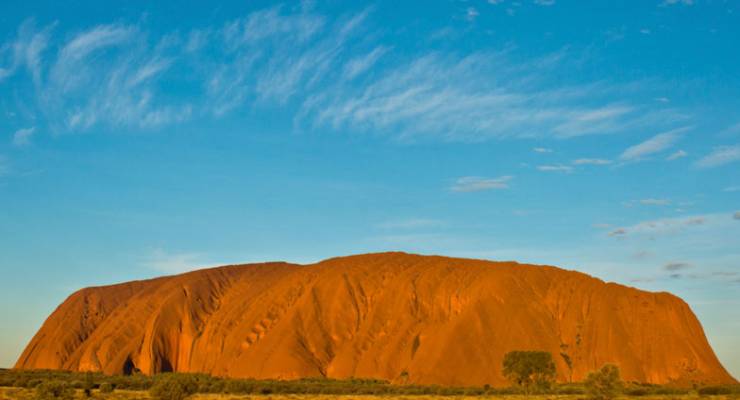
“Please don’t climb.” The sign at the base of Uluru delivers a simple, dignified request from the Anangu people — the traditional owners of the rock and surrounding country.
But still, hundreds of people a day are clambering cheek-to-butt up the side of Uluru, expressing their insistence of the right to do whatever they please before climbing is finally banned on October 26 this year.
I always try to understand, from an empathic positioning, what the hell motivates people’s actions. I kind of get the reflexive demand that Uluru isn’t “theirs”, it’s “ours”, and therefore cannot, should not, be excluded from our basic love of achieving altitude and celebrating our mastery of nature. The small-minded banality of that perspective, however, defeats me.
But rather than engage in the pointless pursuit of arguing with Pauline Hanson about her Indigenousness, let’s have a look at the actual rights at play here.
A history lesson
When I was taught Australian history (which began in 1616 when Dirk Hartog bumped into the coast of WA), we learned that William Gosse discovered Ayers Rock in 1873. Obviously, prior to that, it hadn’t relevantly existed.
From 1950, Ayers Rock was a national park. The surrounding area had been an Aboriginal “reserve” since the early 1900s but remained federal land. Under the Fraser government in 1976, an Aboriginal Land Rights (Northern Territory) Act was legislated to allow for Aboriginal land claims in the NT (a precursor to Mabo and the general recognition of native title in 1992). However, Uluru and the neighbouring Kata Tjuta were specifically excised from the act’s reach and managed by the NT Parks and Wildlife Service.
The traditional owners, the Anangu, wanted the right to make a land title claim over the national park. The NT government was absolutely opposed to this. The federal government, caught in the middle, prevaricated for a decade until Bob Hawke’s election in 1983 and his announcement that year that the Anangu’s wishes were going to be granted.
The “handover” took place in 1985 at the base of Uluru, when governor-general Sir Ninian Stephen signed over the title to the Uluru-Kata Tjuta National Park to the traditional owners, and they leased it back to the Australian Parks and Wildlife Service (APWS, now Parks Australia) for 99 years. The NT government boycotted the ceremony.
As a result, the freehold title to Uluru is now owned by the Uluru-Kata Tjuta Aboriginal Land Trust, on trust for the traditional owners. It is as much public land as Pauline Hanson’s house is public land; which is to say, it is not.
You may or may not like that, but the traditional owners of Australia didn’t much like the alienation without compensation of 100% of their land between 1788 and 1836 either.
The lease back to the APWS preserved public access to Uluru. As part of the management plan, a deal was struck to honour the Anangu’s wish for climbing of the rock to cease once certain conditions were met. These included, critically, that less than 20% of visitors were choosing to climb. That was satisfied in 2017.
The Anangu decided to offer a two-year forewarning of the closure of the climb. I don’t think they were contemplating this as the offer of a last-chance climbing bonanza, but rather as an allowance of time for everyone to get comfortable with the exercise of their legal right.
Collective denial
The fact is that the owners of Uluru have every legal right to prevent people from climbing it. They do not need to defend their choice by reference to tjukurpa (a complex concept that includes the creation period and is central to the spiritual importance of Uluru), or their feeling of responsibility for the (at least 36) deaths that have occurred as a result of climbing the rock since the 1950s. Let alone the defecations, YouTube videos and sundry other defacements inflicted by climbers.
But all of these things matter. Most non-Indigenous Australians have somewhere between no and little understanding of Aboriginal culture, spirituality and tradition. That’s been our collective national choice. So the Anangu’s wish has been routinely dismissed.
We have no difficulty in recognising the right — legal and ethical — of a person who bought waterfront land to not allow us to walk on their patch of beach. We can understand emotional reactions when a sports stadium is demolished, because it’s the spiritual home of something or other. We care about whether it’s okay to project a horse race onto the Opera House sails.
Yet, when it comes to the cultural claim of an 80,000-year-old tradition — the custodians of which have not sought to shut anyone out but, in the most respectful and careful way imaginable, asked us, warned us and finally told us to at least not walk all over the top of the sacred rock — there’s been precious little pause to reflect.
Instead, there’s been the rush to condemn and to climb. The last-minute trampling is a hell of a metaphor: the symbolic expression of valueless ignorance dressed up as overt disrespect. Who are the ones without culture? The Anangu know.








What a wonderful article. Thank you.
The relatively large cohort of boofhead Australians that do not understand either the cultural offence or the plain old common law rights Micheal so succinctly states here does not auger well for constitutional change that indigenous people so desperately need.
My first visit to Uluru as a callow youth,I thought I would climb and … what? enjoy the vista? go back down? Maybe I was not so callow because I did not climb instead enjoying a deeply enriching experience by circumnavigating and observing historical and contemporary landscape and uses. I repeated the experience a decade or so later. Not climbing turned out to be an excellent choice, and not just for signalling virtue. It is a real story about how taking note of something (a sign asking me not to climb) and acting in an informed way can be rather affirming.
The walk around the rock is, as you say, deeply enriching. You don’t puff, you don’t congratulate yourself – you just absorb. It should be more than enough. I would like to think respect was a sufficient motive for me taking that option, but I’ll never know – I hate heights. Well done to you as a callow youth.
I admit to having climbed it a couple of decades ago and was an $%^& for having done so. Even then the signs asking us not to climb were plain to see. I feel disgusted at myself for being so ignorant.
I hope that the First Peoples accept my apology.
I was at the handback of Uluru in 1985 and it was a wonderful occasion. One of the highlights of my life. The Anangu, on being given back their stolen lands, immediately agreed to allow all Australians access to their land. Bogans repay that generosity of spirit by ignoring their wishes and clambering up Uluru, they go to the toilet on Uluru. So much disrespect for both Uluru and the Traditional Owners.
I